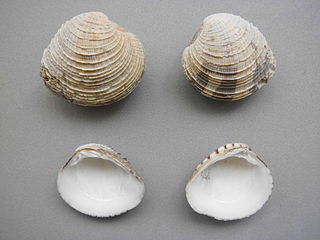
Chione cancellata, is a species of medium-sized saltwater clam, a marine bivalve mollusc in the family Veneridae, the venus clams.
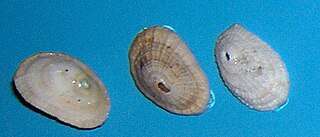
Diodora graeca, the Greek keyhole limpet, is a sea snail or limpet, a marine gastropod mollusk in the family Fissurellidae, the keyhole limpets.
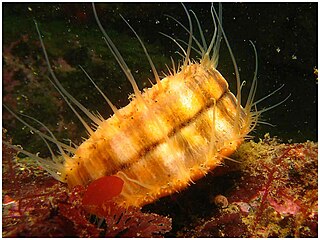
Chlamys hastata, the spear scallop, spiny scallop or swimming scallop, is a species of bivalve mollusc in the family Pectinidae found on the west coast of North America from the Gulf of Alaska to San Diego, California. A limited number of these scallops are harvested by divers or by narrow trawls off the west coast of Canada.

Lacuna vincta, commonly known as the northern lacuna, the wide lacuna, the northern chink shell, or the banded chink shell, is a species of sea snail, a marine gastropod mollusk in the family Littorinidae, the winkles or periwinkles. It is found intertidally and in shallow waters in both the northern Atlantic Ocean and the northern Pacific Ocean. It is a herbivore, feeding on seaweed and diatoms with its toothed radula.

Anodontia alba, or the buttercup lucine, is a species of bivalve mollusc in the family Lucinidae. It can be found along the Atlantic coast of North America, its range extending from North Carolina in the United States to the West Indies.

Novocrania anomala is a species of brachiopod found offshore in the eastern Atlantic Ocean.
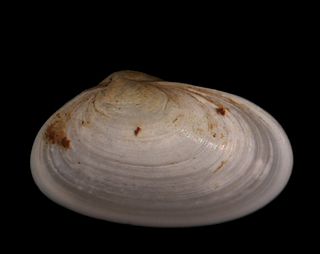
Tellimya ferruginosa is a species of small marine bivalve mollusc in the family Lasaeidae. It is found on the eastern side of the Atlantic Ocean.
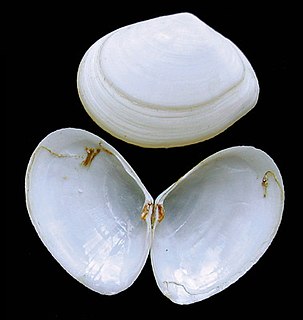
Abra alba, or the white furrow shell, is a species of bivalve mollusc in the family Semelidae. It occurs in the northeastern Atlantic Ocean and the Mediterranean Sea, where it lives on the floor in shallow areas buried in soft sediments.
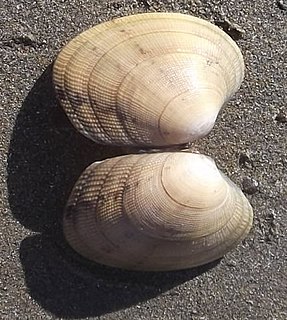
Venerupis decussata is a marine bivalve mollusc in the family Veneridae, commonly known as the cross-cut carpet shell.

Cyrtopleura costata, or the angel wing clam, is a bivalve mollusc in the family Pholadidae. It is found in shallow parts of the northwest Atlantic and also in the North Sea of Scotland coastline and west coast of the Adriatic Sea by a remote area in the Marche region in central Italy, living in the seabed, where it digs its burrows on a very slow revolving movement for years through soft sand and mud always to a max depth of 8ft but always below 3 feet (0.91 m) at the lowest tide.

Thecacera pennigera, common name the winged thecacera, is a species of sea slug, a nudibranch, a shell-less marine gastropod mollusc in the family Polyceridae.

Thracia convexa is a bivalve mollusc in the family Thraciidae.

Donax vittatus, or the banded wedge shell, is a species of bivalve mollusc in the order Cardiida. It is found on beaches in northwest Europe buried in the sand on the lower shore.
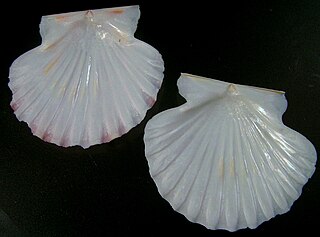
Annachlamys flabellata is a species of scallop, a marine bivalve mollusc in the family Pectinidae. It is found in the sublittoral zone of the continental shelf north of Australia.

Poromya granulata, or the granular poromya, is a species of marine bivalve mollusc in the family Poromyidae. It is unusual among bivalves in being carnivorous. It is found in more northerly parts of the Atlantic Ocean.
Mulinia lateralis, the dwarf surf clam or coot clam, is a species of small saltwater clam, a bivalve mollusc in the family Mactridae. It occurs in the western Atlantic Ocean and the Caribbean Sea.
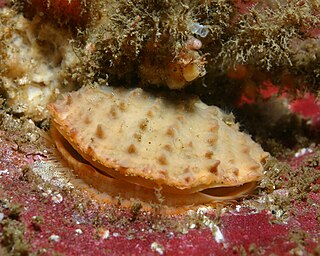
Crassadoma is a genus of rock scallops, marine bivalve molluscs in the family Pectinidae. It is monotypic, the only species being Crassadoma gigantea, the rock scallop, giant rock scallop or purple-hinge rock scallop. Although the small juveniles are free-swimming, they soon become sessile, and are cemented to the substrate. These scallops occur in the eastern Pacific Ocean.

Limaria fragilis, the fragile file clam, is a species of bivalve mollusc in the family Limidae. It is found in shallow waters in the Indian and Pacific Oceans and has the ability to swim.

Venerupis corrugata, the pullet carpet shell, is a species of bivalve mollusc in the family Veneridae. It is found buried in the sediment on the sea bed in shallow parts of the eastern Atlantic Ocean. It is harvested for human consumption in Spain and other parts of Western Europe.

Ophiopholis aculeata, the crevice brittle star or daisy brittle star, is a species of brittle star in the family Ophiactidae. It has a circum-polar distribution and is found in the Arctic Ocean, the northern Atlantic Ocean and the northern Pacific.



















